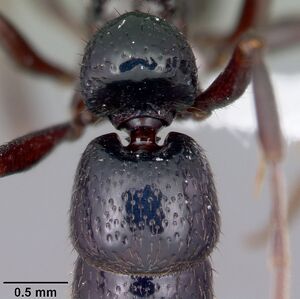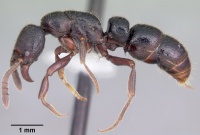Euponera agnivo
| Euponera agnivo | |
|---|---|

| |
| Scientific classification | |
| Kingdom: | Animalia |
| Phylum: | Arthropoda |
| Class: | Insecta |
| Order: | Hymenoptera |
| Family: | Formicidae |
| Subfamily: | Ponerinae |
| Tribe: | Ponerini |
| Genus: | Euponera |
| Species complex: | sikorae |
| Species: | E. agnivo |
| Binomial name | |
| Euponera agnivo (Rakotonirina & Fisher, 2013) | |
This species has been collected by sampling leaf litter in the central east of Madagascar and was only recorded once from a pitfall trap in Andohahela. The shallow impression on the anterior face of the first gastral segment matches the shape of the posterior section of the petiolar node, suggesting this hollow plays a role in lodging the posterior face of the node.
Identification
Rakotonirina and Fisher (2013) - Worker. Anteromedian margin of clypeus broadly convex; posterolateral margins of propodeum and petiolar node smooth, without sharp teeth or tubercles; anterior surface of first gastral segment concave, forming a shallow impression to lodge the posterior surface of petiole.
Euponera agnivo can be recognized easily by the medially convex anterior margin of its clypeus and the presence of a shallow impression on the anterior face of its first gastral tergite. No striking morphological variation is observed in this species despite the great distance between collection localities in the south and the center of Madagascar.
Keys including this Species
Distribution
Euponera agnivo is an endemic species found in mid-elevation areas of eastern Madagascar. In addition to the type locality, the species occurs in the PN Mantadia in the central east and in the PN Andohahela in the southernmost portion of the island. (Rakotonirina and Fisher 2013)
Latitudinal Distribution Pattern
Latitudinal Range: -18.695° to -18.695°.
| North Temperate |
North Subtropical |
Tropical | South Subtropical |
South Temperate |
- Source: AntMaps
Distribution based on Regional Taxon Lists
Malagasy Region: Madagascar (type locality).
Distribution based on AntMaps
Distribution based on AntWeb specimens
Check data from AntWeb
Countries Occupied
| Number of countries occupied by this species based on AntWiki Regional Taxon Lists. In general, fewer countries occupied indicates a narrower range, while more countries indicates a more widespread species. |

|
Estimated Abundance
| Relative abundance based on number of AntMaps records per species (this species within the purple bar). Fewer records (to the left) indicates a less abundant/encountered species while more records (to the right) indicates more abundant/encountered species. |

|
Biology
Castes
Known only from the worker caste.
Images from AntWeb

| |
| Holotype of Euponera agnivo. Worker. Specimen code casent0317589. Photographer Jean Claude Rakotonirina, uploaded by California Academy of Sciences. | Owned by CAS, San Francisco, CA, USA. |
Nomenclature
The following information is derived from Barry Bolton's Online Catalogue of the Ants of the World.
- agnivo. Pachycondyla agnivo Rakotonirina & Fisher, 2013: 458, figs. 16, 28, 29, 30, 70 (w.) MADAGASCAR. Combination in Euponera: Schmidt & Shattuck, 2014: 86.
Unless otherwise noted the text for the remainder of this section is reported from the publication that includes the original description.
Description
Worker
(3 specimens): HW: 1.14–1.15, HL: 1.36–1.40, CI: 82–84, SL: 1.01–1.03, SI: 88–90, PW: 1.01–1.03, WL: 1.96–2.04, NH: 0.87–0.89, NL: 0.63–0.68, NW: 0.94–0.96, DNI: 143–150, LNI: 129–138.
In full face-view, head broader posteriorly; sides slightly convex; posterior margin feebly concave. Dorsum of head reticulate-punctate anteriorly and densely punctate behind from about the posterior third. Eyes large, maximum diameter nearly the same as the greatest width of antennal scape. Scape barely reaching posterior cephalic margin. Anteromedian clypeal margin convex. Mandibles sparsely punctate, the space between punctures smooth and shiny; masticatory margin armed with 12 teeth or denticles.
With mesosoma in dorsal view, metanotal groove obsolete; in profile, mesopleural suture absent or indistinct; posterior magin of propodeum without a series of sharp teeth or tubercles; junction of lateral propodeal surface and declivity angulate, angles fairly emarginate. Dorsum of mesosoma with punctate sculpture. Petiole nodiform, anterodorsal angle faintly overhanging anterior margin in lateral view; subpetiolar process consisting of convex anterior face and broadly subquadrate posterior margin; in dorsal view node slightly broader than long, lateral border roughly convex and converging in a rounded line to the more or less straight anterior face; posterior margin medially broadly convex; dorsum of node sparsely punctate.
Anterior face of first gastral segment with shallow cavity, which is deeper near the insertion of petiole and becomes superficial towards the anterodorsal angle. With gaster in ventral view, anterior half of first gastral sternite with impressions on both sides of helcium; in profile anteroventral portion rounded and anteriorly projecting as hooklike process (the prora). Dorsum of first two gastral tergites smooth between piligerous punctures.
Dorsum of head and body covered with erect hairs; pubescence quite abundant on head dorsum and scarce or absent on the rest of body dorsum. Body color black with bluish reflection; appendages and tip of gaster brown.
Type Material
Holotype worker: Madagascar, Toamasina, FC Andriantantely, -18.695, 48.8133, 530 m, sifted litter, rainforest, 7–10 Dec 1998 (H.J. Ratsirarson), collection code: HJR122, specimen code: CASENT0317589 (California Academy of Sciences).
References
- Rakotonirina, J.C. & Fisher, B.L. 2013. Revision of the Pachycondyla sikorae species-group (Hymenoptera: Formicidae) in Madagascar. Zootaxa 3683, 447-485.
- Schmidt, C.A. & Shattuck, S.O. 2014. The higher classification of the ant subfamily Ponerinae (Hymenoptera: Formicidae), with a review of ponerine ecology and behavior. Zootaxa 3817, 1–242 (doi:10.11646/zootaxa.3817.1.1).

